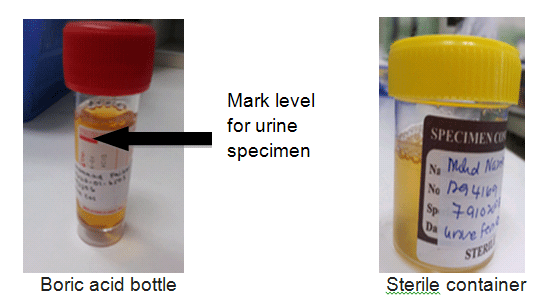Introduction
Urine is a liquid waste product of the body which is removed by the kidneys through a process of filtration from blood and excreted through the urethra. Urine is normally considered as sterile body fluids; however, it is easily contaminated with microbiota from the perineum, prostate, urethra, or vagina. The presence of bacteria in urine is called bacteriuria. It is usually regarded significant when the urine contains 105 organisms / per ml urine in pure culture. Urinary tract infections often occur more frequently in women than men. This happens because the woman’s urethra is shorter and closer to the anus which allows bacteria from the intestines into the urethra. In addition, men have antibacterial substances in the prostate gland that reduces the risk of bacterial infection. Escherichia coli is the most common pathogen causing urinary tract infections, between 60-90%.

E.coli bacteria
Collecting proper urine specimen is very important to provide a significant test results and to determine the treatment to be given to the patient. Contamination during the process of sampling and transportation of urine specimens can lead to errors in diagnosis. For women, taking urine samples during menstruation is avoided.
Urine sampling method
- Midstream Urine
The ideal specimen of urine is ‘midstream urine’, where the initial flow of urine is thrown and the consequent urine flow will be collected in sterile containers provided. Patients will be given a sterile container and clear explanation on urine collection to avoid as much contamination as possible. Whenever possible, the first urine passed by the patient at the beginning of the day should be sent for examination. This specimen is the most concentrated and therefore the most suitable for culture, microscopy, and biochemical analysis.
Female patients:
Thoroughly clean urethral area with soap and water. Rinse area with wet gauze pad. After several ml have passed, collect midstream portion into sterile urine container.
Male patients:
Clean the glands with soap and water. Rinse area with wet gauze pad. After several ml have passed, collect midstream portion into sterile urine container.
- Urine ‘Catheter’
Silicone tube known as a urinary catheter is inserted into a patient’s bladder via the urethra. Catheterization allows the patient’s urine to drain freely from the bladder for collection. A clinician, often a nurse, usually performs the procedure. Urine specimen collection in this way can reduce the contamination caused by the environmental bacteria.
Sample container and transportation
Sterile containers should be clearly labeled with patient’s name, identification number, time and date of collection. Deliver the specimen with a request form to the laboratory as soon as possible. When immediate delivery to the laboratory is not possible, refrigerate the urine at 4-6Oc. When a delay in delivery of more than 2 hours is anticipated, urine must be collected in acid boric container. However with the boric acid container, it is critical that the urine volume must be up to the stipulated arrow mark. At a concentration of boric acid 10g/l, bacteria remain viable without multiplying.
Boric acid has been shown to be inhibitory to some Enterococci and Pseudomonas strains. Patients who might not be able to produce this amount of urine are advised to use the normal sterile container and specimen should be delivered within 2 hours, 4-6oC to the laboratory for analysis.

Specimen rejection criteria
- Urine specimens in sterile containers not sent in ice and beyond 2 hours of collection.
- Collection time and date of the specimen have not been provided.
- Urine specimens more than 24 hours (boric acid bottle).
- Specimen that arrive in leaky container.
- Boric acid containers with too much or too little volume, other than the arrow mark level.
- Urine contamination with stool.
- Information on the request form and container does not match.
References
- Clinical Microbiology Procedures Handbook, Third Edition, Lynne S. Garcia
- District Laboratory Practice in Tropical Country, Second Edition, Monica Cheesbrough
| Last Reviewed | : | 20 June 2014 |
| Writer/Translator | : | Noraini bt. Hussain |
| Accreditor | : | Nasruddin bin Muslim |







